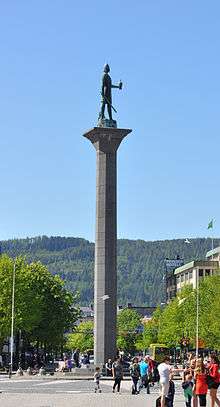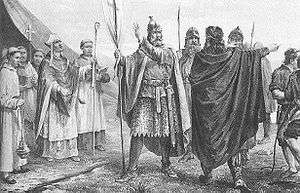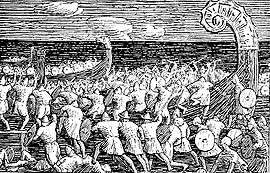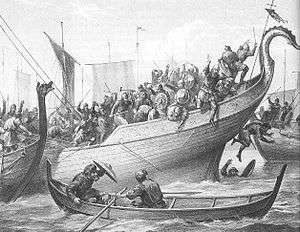Olaf Tryggvason
| Olaf Tryggvason | |
|---|---|
 Only known type of coin of Olaf Tryggvason, in four known specimens. Imitation of the Crux-type coin of Æthelred the Unready.[1] | |
| King of Norway | |
| Reign | 995 – 1000 |
| Predecessor | Sweyn Forkbeard |
| Successor | Sweyn Forkbeard |
| Born |
960s Norway |
| Died |
1000 Svolder, Norway |
| Spouse |
Geira of Wendland Gyda of Dublin Gudrun Skeggesdatter Tyra of Denmark |
| Issue | Tryggvi the Pretender (possibly) |
| Father | Tryggve Olafsson |
| Mother | Astrid Eiriksdatter |
Olaf Tryggvason (960s – 1000) was King of Norway from 995 to 1000. He was the son of Tryggvi Olafsson, king of Viken (Vingulmark, and Rånrike), and, according to later sagas, the great-grandson of Harald Fairhair, first King of Norway.
Olaf played an important part in the conversion of the Norse to Christianity, often by forcible means.[2][3][4] He is said to have built the first church in Norway (in 995) and to have founded the city of Trondheim (in 997). A statue of Olaf Tryggvason is located in the city's central plaza.
Historical information about Olaf is sparse. He is mentioned in some contemporary English sources,[5] and some skaldic poems. The oldest narrative source mentioning him briefly is Adam of Bremen's Gesta Hammaburgensis ecclesiae pontificum (c. 1070). In the 1190s, two sagas of Olaf Tryggvason were written in Iceland, by Oddr Snorrason and Gunnlaugr Leifsson. Snorri Sturluson gives an extensive account of Olaf in the Heimskringla saga, (c. 1230), using Oddr Snorrason's saga as his main source. The accuracy of these late sources is not taken at face value by modern historians and their validity is a topic of some debate.[6] The following account is mainly based on the late saga sources.
Birth and early life

There is uncertainty about both the date and the place of Olaf's birth. The earliest Norwegian written source, the late 12th century Historia Norwegiæ, states that Olaf was born in the Orkney Islands after his mother fled there to escape the killers of Olaf's father. Another late 12th-century source, Ágrip af Nóregskonungasögum, says Olaf's mother fled to Orkney with Olaf when he was three years old, for the same reason. All the sagas agree that Olaf eventually ended up in Kievan Rus', at the court of King Valdemar.[7]
The version in Heimskringla is the most elaborate, but also the latest, and introduces elements to the story that are not found in earlier sources. It states that Olaf was born shortly after the murder of his father in 963, while other sources suggest a date between 964 and 969. The later dates cast doubt over Olaf's claim to be of Harald Fairhair's kin, and the legitimacy of his claim to the throne. Snorri Sturluson claims in Olaf Tryggvson's saga that Olaf was born on an islet in Fjærlandsvatnet, where his mother Astrid Eiriksdottir, daughter of Eirik Bjodaskalle, was hiding from her husband's killers, led by Harald Greycloak, the son of Eirik Bloodaxe. Greycloak and his brothers had seized the throne from Haakon the Good. Astrid fled to her father's home in Oppland, then went on to Sweden where she thought she and Olaf would be safe. Harald sent emissaries to the king of Sweden, and asked for permission to take the boy back to Norway, where he would be raised by Greycloak's mother Gunhild. The Swedish king gave them men to help them claim the young boy, but to no avail. After a short scuffle Astrid (with her son) fled again. This time their destination was Gardarike (Kiev), where Astrid's brother Sigurd was in the service of King Valdemar (Vladimir I). Olaf was three years old when they set sail on a merchant ship for Novgorod. The journey was not successful: in the Baltic Sea they were captured by Estonian vikings, and the people aboard were either killed or taken as slaves. Olaf became the possession of a man named Klerkon, together with his foster father Thorolf and his son Thorgils. Klerkon considered Thorolf too old to be useful as a slave and killed him, and then sold the two boys to a man named Klerk for a ram. Olaf was then sold to a man called Reas for a fine cloak.[8] Six years later, Sigurd Eirikson traveled to Estonia to collect taxes for King Valdemar. He saw a boy who did not appear to be a native. He asked the boy about his family, and the boy told him he was Olaf, son of Tryggve Olafson and Astrid Eiriksdattir. Sigurd then went to Reas and bought Olaf and Thorgils out from slavery, and took the boys with him to Novgorod to live under the protection of Valdemar.
Still according to Heimskringla, one day in the Novgorod marketplace Olaf encountered Klerkon, his enslaver and the murderer of his foster father. Olaf killed Klerkon with an axe blow to the head. A mob followed the young boy as he fled to his protector Queen Allogia, with the intent of killing him for his misdeed. Only after Allogia had paid blood money for Olaf did the mob calm down. As Olaf grew older, Vladimir made him chief over his men-at-arms, but after a couple years the king became wary of Olaf and his popularity with his soldiers. Fearing he might be a threat to the safety of his reign, Vladimir stopped treating Olaf as a friend. Olaf decided that it was better for him to seek his fortune elsewhere, and set out for the Baltic.
Raiding
Heimskringla states that after leaving Novgorod, Olaf raided settlements and ports with success. In 982 he was caught in a storm and made port in Wendland, where he met Queen Geira, a daughter of King Burizleif. She ruled the part of Wendland in which Olaf had landed, and Olaf and his men were given an offer to stay for the winter. Olaf accepted and after courting the Queen, they were married. Olaf began to reclaim the baronies which while under Geira's rule had refused to pay taxes. After these successful campaigns, he began raiding again both in Skåne and Gotland.
Alliance with Otto II
Holy Roman Emperor Otto II had assembled a great army of Saxons, Franks, Frisians and Wends to fight against the Norse pagan Danes. Olaf was part of this army as his father-in-law was king of Wendland. Otto's army met the armies of King Harald Bluetooth and Haakon Jarl the ruler of Norway under the Danish king, at Danevirke, a great wall near Schleswig. Otto's army was unable to break the fortification, so he changed tactics and sailed around it, landing in Jutland with a large fleet. Otto won a large battle there, and forced Harald and Haakon with their armies to convert to Christianity. Otto's army then returned to their homelands. Harald would hold on to his new faith, but Haakon continued worshiping the old gods when he got home.
Death of Geira and conversion
.jpg)

After Olaf had spent three years in Wendland, his wife Geira died. He felt so much sorrow from her death that he could no longer bear to stay in Wendland, and set out to plunder in 984. He raided from Friesland to the Hebrides. After four years he landed on one of the Scilly Isles. He heard of a seer who lived there. Desiring to test the seer, he sent one of his men to pose as Olaf. But the seer was not fooled. So Olaf went to see the hermit, now convinced he was a real fortune teller. And the seer told him:
Thou wilt become a renowned king, and do celebrated deeds. Many men wilt thou bring to faith and baptism, and both to thy own and others' good; and that thou mayst have no doubt of the truth of this answer, listen to these tokens. When thou comest to thy ships many of thy people will conspire against thee, and then a battle will follow in which many of thy men will fall, and thou wilt be wounded almost to death, and carried upon a shield to thy ship; yet after seven days thou shalt be well of thy wounds, and immediately thou shalt let thyself be baptized.
After the meeting Olaf was attacked by a group of mutineers, and what the seer had foretold happened. So Olaf let himself be baptised.
David Hugh Farmer, in the Oxford Dictionary of Saints, writes 'it is tempting' to identify the seer with Saint Lide who lived on the island of St Helen's in the Isles of Scilly.[9]
By another account, he was baptised by St. Ælfheah of Canterbury near to Andover, Hampshire in 994.[10] However, Henrietta Leyser, the author of Ælfheah's Oxford Nation Dictionary of Biography entry, states that Olaf was already baptised and that the 994 event at Andover was a confirmation of his faith, part of a Danegeld treaty in which he agreed to no longer raid in England.[11]
Marriage to Gyda
In 988, Olaf sailed to England, because a thing had been called by Queen Gyda, sister of Olaf Cuaran, King of Dublin. Gyda was the widow of an earl, and was searching for a new husband. A great many men had come, but Gyda singled out Olaf, though he was wearing his bad weather clothes, and the other men wore their finest clothing. They were to be married, but another man, Alfvine, took objection, and challenged Olaf and his men to the Scandinavian duel or holmgang. Olaf and his men fought Alfvine's crew and won every battle, but did not kill any of them, instead they bound them. Alfvine was told to leave the country and never come back again. Gyda and Olaf married, and spent half their time in England and the other half in Ireland.

Based on drawing by Peter Nicolai Arbo
Ascent to the throne

In 995, rumours began to surface in Norway about a king in Ireland of Norwegian blood. This caught the ear of Jarl Haakon, who sent Thorer Klakka to Ireland, posing as a merchant, to see if he was the son of Tryggve Olafson. Haakon told Thorer that if it were him, to lure him to Norway, so Haakon could have him under his power. Thorer befriended Olaf and told him of the situation in Norway, that Haakon Jarl had become unpopular with the populace, because he often took daughters of the elite as concubines, which was his right as ruler. He quickly grew tired of them and sent them home after a week or two. He had also been weakened by his fighting with the Danish king, due to his rejection of the Christian faith.
Olaf seized this opportunity, and set sail for Norway. When he arrived many men had already started a revolt against Haakon, who was forced to hide in a hole dug in a pigsty, together with one of his slaves Kark. When Olaf met the rebels they accepted him as their king, and together they started to search for Haakon. They eventually came to the farm where Haakon and Kark were hiding, but could not find them. Olaf held a meeting just outside the swine-sty and promised a great reward for the man who killed the Jarl. The two men in the hole heard this speech, and Haakon became distrustful of Kark, fearing he would kill him to claim the price. He could not leave the sty, nor could he keep awake forever, and when he fell asleep Kark took out a knife and cut Haakon's head off. The next day the slave went to meet Olaf and presented with the head of Haakon. The king did not reward him, and instead beheaded the slave.
After his confirmation as King of Norway, Olaf traveled to the parts of Norway that had not been under the rule of Haakon, but that of the King of Denmark; they too swore allegiance to him. He then demanded that they all be baptised, and most reluctantly they agreed.
Ruinke as king

In 997 Olaf founded his seat of government in Trondheim, where he had first held a thing with the revolters against Haakon. It was a good site because the River Nid twisted itself before going into the fjord, creating a peninsula that could be easily defended against land attacks by just one short wall.
Olaf continued to promote Christianity throughout his rule. He baptized the explorer Leif Ericson, and Leif took a priest with him back to Greenland to convert the rest of his kin.[12] Olaf also converted the people and Earl of the Orkney Islands to Christianity.[13] At that time, the Orkney Islands were part of Norway.
It has been suggested that Olaf's ambition was to rule a united Christian Scandinavia, and it is known that he made overtures of marriage to Sigrid the Haughty, queen of Sweden, but negotiations fell through due to her steadfast pagan faith. Instead he made an enemy of her, and did not hesitate to involve himself in a quarrel with King Sweyn I of Denmark by marrying Sweyn's sister Thyre, who had fled from her heathen husband Burislav, semi-legendary "king of Wends", in defiance of her brother's authority.
Both his Wendish and his Irish wife had brought Olaf wealth and good fortune, but, according to the sagas, they were his undoing, for it was on an expedition undertaken in the year 1000 to wrest her lands from Burislav that he was waylaid off the island Svolder, by the combined Swedish, Danish, and Wendish fleets, together with the ships of Earl Haakon's sons. The Battle of Svolder ended in the death of the Norwegian king. Olaf fought to the last on his great vessel Ormrinn Langi ("Long Serpent"), the mightiest ship in the North, and finally leapt overboard and was seen no more.

Peter Nicolai Arbo
In the early 11th century a Viking chieftain named Tryggvi invaded Norway, claiming to be the son of Olaf and Gyda. His invasion was defeated by forces loyal to Cnut the Great's son Svein of Norway.
An account preserved in Morkinskinna relates that Tryggvi was actually killed by a farmer after the battle. Many years later, when Harald Hardrada was king of Norway, he passed by the site of the battle. The king met an old friend of his who pointed out the alleged assassin. After questioning the purported killer and hearing him confess, King Harald had the man hanged, citing the familial bond between him and Tryggvi and his duty to avenge the latter's death.[14]
Rumours of survival
For some time after the Battle of Svolder, there were rumors that Olaf had survived his leap into the sea and had made his way to safety. Accounts reported by Oddr Snorrason included sightings of Olaf in Rome, Jerusalem, and elsewhere in Europe and the Mediterranean. Both King Ethelred the Unready and Olaf's sister Astrid allegedly received gifts from Olaf long after he was presumed dead. The latest sighting reported by Oddr took place in 1046.[15]
Forcible conversions
Olaf routinely used force to compel conversions to Christianity, including executions and torture of those who refused. Several instances of Olaf's attempts led to days of remembrance amongst modern heathens similar to the feast days of martyred Christian saints. Raud the Strong (remembered 9 January) refused to convert and, after a failed attempt using a wooden pin to pry open his mouth to insert a snake, was killed by a snake goaded by a hot poker through a drinking horn into Raud's mouth and down his throat. Eyvind Kinnrifi (9 February) likewise refused and was killed by a brazier of hot coals resting on his belly. The possibly apocryphal figure, Sigrid the Haughty (9 November), was said to have refused to marry Olaf if it meant forgoing her forefathers' religion, upon which Olaf slapped her with his glove, an act that prompted her to unite his enemies against him some years later.
Ancestors from the sagas
| Ancestry of Olaf Tryggvason given in the sagas - many connections are dubious | |||||||||||||||||||||||||||||||||||||||||||||||||||||||||||||||||||||||||||||||||||||||||||||||||||||||||||||||||||||||||||||||||||||||||||||||||||||||||||||||||||||||||||||||||||||||||||||||||||||||||||||||||||||||||||||||
|---|---|---|---|---|---|---|---|---|---|---|---|---|---|---|---|---|---|---|---|---|---|---|---|---|---|---|---|---|---|---|---|---|---|---|---|---|---|---|---|---|---|---|---|---|---|---|---|---|---|---|---|---|---|---|---|---|---|---|---|---|---|---|---|---|---|---|---|---|---|---|---|---|---|---|---|---|---|---|---|---|---|---|---|---|---|---|---|---|---|---|---|---|---|---|---|---|---|---|---|---|---|---|---|---|---|---|---|---|---|---|---|---|---|---|---|---|---|---|---|---|---|---|---|---|---|---|---|---|---|---|---|---|---|---|---|---|---|---|---|---|---|---|---|---|---|---|---|---|---|---|---|---|---|---|---|---|---|---|---|---|---|---|---|---|---|---|---|---|---|---|---|---|---|---|---|---|---|---|---|---|---|---|---|---|---|---|---|---|---|---|---|---|---|---|---|---|---|---|---|---|---|---|---|---|---|---|---|---|---|---|---|---|---|---|---|---|---|---|---|---|---|---|---|
| |||||||||||||||||||||||||||||||||||||||||||||||||||||||||||||||||||||||||||||||||||||||||||||||||||||||||||||||||||||||||||||||||||||||||||||||||||||||||||||||||||||||||||||||||||||||||||||||||||||||||||||||||||||||||||||||
See also
- Edward Elgar
- Garðaríki
- HNoMS Olav Tryggvason
- The Saga of King Olaf
- Óláfs saga Tryggvasonar (Oddr Snorrason)
- Óláfs saga Tryggvasonar en mesta
References
- ↑ Skaare, Kolbjørn (1995). Norges mynthistorie. Universitetsforlaget. pp. 38-41.
- ↑ http://www.katolsk.no/biografi/olav/eng_07.htm retrieved 10 February 2011
- ↑ http://www.shadowdrake.com/religion.html retrieved 10 February 2011
- ↑ Heimskringla, King Olaf Trygvason's Saga, section 52
- ↑ E.g. Diplomatarium Norvegicum XIX, nr. 1
- ↑ Sverre Bagge, Helgen, helt og statsbygger - Olav Tryggvason i norsk historieskrivning gjennom 700 år, in Steinar Supphellen (ed.), Kongsmenn og Krossmenn - Festskrift til Grethe Authén Blom, (Trondheim, 1992)
- ↑ Bagge, Sverre (2006), "The Making of a Missionary King: The Medieval Accounts of Olaf Tryggvason and the Conversion of Norway", The Journal of English and Germanic Philology, 105 (4): 486–487
- ↑ Heimskringla saga.
- ↑ David Farmer (14 April 2011). The Oxford Dictionary of Saints, Fifth Edition Revised. Oxford University Press. p. 272. ISBN 0-19-959660-3.
- ↑ Stenton Anglo-Saxon England p. 378
- ↑ "Ælfheah (d. 1012)". Oxford Dictionary of National Biography (online ed.). Oxford University Press. doi:10.1093/ref:odnb/181. (Subscription or UK public library membership required.)
- ↑ Snorre Sturlason, Heimskringla, Or the Lives of the Norse Kings, Kessinger Publishing, 2004, p.188 ISBN 0-7661-8693-8
- ↑ Covenant Worldwide - Ancient & Medieval Church History
- ↑ Gade (2000:255).
- ↑ Oddr Snorrason.The Saga of King Olaf Tryggwason. Shepton, J., transl. Nutt, 1895. 449–465.
 This article incorporates text from a publication now in the public domain: Chisholm, Hugh, ed. (1911). "Olaf, the name of five kings of Norway". Encyclopædia Britannica (11th ed.). Cambridge University Press.
This article incorporates text from a publication now in the public domain: Chisholm, Hugh, ed. (1911). "Olaf, the name of five kings of Norway". Encyclopædia Britannica (11th ed.). Cambridge University Press.
External links
| Wikimedia Commons has media related to Olaf I of Norway. |
- Robert Leighton (d. 1934), Olaf the Glorious: A Story of the Viking Age at wisdomlib.org; at ebooks2ebooks.com
- Heimskringla: The Saga of Olaf Tryggvason (English translation) on Wikisource
- Heimskringla: Saga Ólafs Tryggvasonar (Old Norse)
 "Olaf I. Trygvasson". New International Encyclopedia. 1905.
"Olaf I. Trygvasson". New International Encyclopedia. 1905.
| Olaf Tryggvason Cadet branch of the Fairhair dynasty Born: 960s Died: 9 September 1000 | ||
| Regnal titles | ||
|---|---|---|
| Vacant De facto power held by Haakon Sigurdsson Title last held by Sweyn Forkbeard |
King of Norway 995–1000 |
Vacant Title next held by Sweyn Forkbeard |